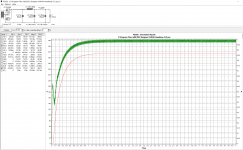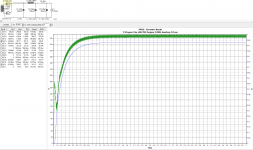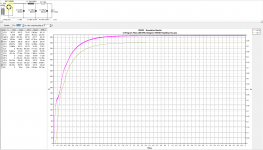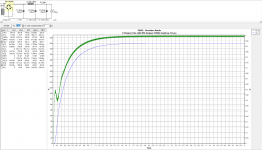I've got 2 semi-related questions regarding PSU in SET amp.
1) CLCRC (tube rectified).
B+ 315V @ 100mA.
L = 10H, 150ohm.
2 combinations reach the same target voltage,
-5U4GB with R=270ohm
-5R4GYB with R=50ohm
The first option has more resistance in the PSU (420ohm vs 200ohm), but lower ripple (based on PSUD).
Also, alot more voltage is burned on the resistor vs. the rectifier.
Which is better and why?
2) CLCRC (SS rectified)
200uF-100uF-100uF or
100uF-100uF-200uF
Is there a difference?
PSUD gives about the same ripple result at the last cap, is there any other consideration?
Thanks!!
1) CLCRC (tube rectified).
B+ 315V @ 100mA.
L = 10H, 150ohm.
2 combinations reach the same target voltage,
-5U4GB with R=270ohm
-5R4GYB with R=50ohm
The first option has more resistance in the PSU (420ohm vs 200ohm), but lower ripple (based on PSUD).
Also, alot more voltage is burned on the resistor vs. the rectifier.
Which is better and why?
2) CLCRC (SS rectified)
200uF-100uF-100uF or
100uF-100uF-200uF
Is there a difference?
PSUD gives about the same ripple result at the last cap, is there any other consideration?
Thanks!!
For question 1:
Attaching the PSUD, although the question was more theoretical (i.e, is load regulation better with less resistance and voltage dropped via rectifier or the opposite)
Ripple for each is (running sim. after a few seconds)
5U4 is 793uV
5R4 is 3.7mV
Note: the 5R4 voltage is higher in the sim. but in testing in the circuit, these values for R result in the same target B+.
For question 2:
Ripple with 220uF first is 600uV
Ripple with 100uF first is 880uV.
Obviously not a significant difference, but wondering if there is any other consideration.
Attaching the PSUD, although the question was more theoretical (i.e, is load regulation better with less resistance and voltage dropped via rectifier or the opposite)
Ripple for each is (running sim. after a few seconds)
5U4 is 793uV
5R4 is 3.7mV
Note: the 5R4 voltage is higher in the sim. but in testing in the circuit, these values for R result in the same target B+.
For question 2:
Ripple with 220uF first is 600uV
Ripple with 100uF first is 880uV.
Obviously not a significant difference, but wondering if there is any other consideration.
for this specific amp, this is the PSU configuration chosen based on size/cost/ etcWhy no tube based regulator?
Attachments
I only use poly caps as input caps if I do CLC. The first cap has to be a tank but good filter too and the electrolytic cap is the worst at this as it has more losses and leakage than other types. You have the ripple coming from the main AC frequency but also a lot of un-related garbage....that's where the electrolytic is less effective.
You can buy the so-called DC-link capacitors at affordable price. Several common brands manufacture this kind of capacitor nowadays. 47uF won't be too big either and also voltage ratings are generally higher which is not a bad thing to have. Larger values are also available if you use SS rectifier.
I am not sure you will see a difference on the simulator but in practice you will ear it quite clearly if everything works well.
You can buy the so-called DC-link capacitors at affordable price. Several common brands manufacture this kind of capacitor nowadays. 47uF won't be too big either and also voltage ratings are generally higher which is not a bad thing to have. Larger values are also available if you use SS rectifier.
I am not sure you will see a difference on the simulator but in practice you will ear it quite clearly if everything works well.
Also your choke has rather high resistance for 10H. A good 10H/100mA would have 30-40R, max 60R. You might be better off with a proper capacity multiplier, especially if you use SS rectifier.
I agree with 45. I use cap multiplier circuits for certain applications and they perform very well.
Now... try this. after 4 seconds, change the current load by 5-10%. Look at how fast the circuit recovers from this. Edit the current sink and make it a stepped load after a few seconds... 😉
Also, why not choke input supply? why only 5u4gb and not TV damper diodes?
and yes.. your 10H choke has how much resistance? And your power transformer.. these are not real values, right? Do you know the off-load voltages and winding resistances? or maybe this is this just an exercise...
Ian
Now... try this. after 4 seconds, change the current load by 5-10%. Look at how fast the circuit recovers from this. Edit the current sink and make it a stepped load after a few seconds... 😉
Also, why not choke input supply? why only 5u4gb and not TV damper diodes?
and yes.. your 10H choke has how much resistance? And your power transformer.. these are not real values, right? Do you know the off-load voltages and winding resistances? or maybe this is this just an exercise...
Ian
Thanks for the tip on cap multiplier, I am not familiar with those so will take a look.
The values are fairly accurate.
It is a PSU for an RH84, taken off the standard PSU here: RH Amplifiers: RH84 amplifier - revision 2
Nothing out of the ordinary here, just a CLC, 47uF-10H-200uF.
The PT in both the real circuit and the simulation is 600VCT @ 200mA, so the B+ is higher than needed. The additional RC filter is to drop the additional voltage and reduce ripple.
I can use different combination of rectifer/resistor to reach the target B+, hence the question
Why 5U4GB? Simply because I have those and 5R4-GYB on hand, so want to use them.
I can't use Choke input with this PT, I would need a much higher secondary.
The Choke is a Hammond 159P, 10H@125mA, 155ohms.
A similar (but heavier duty) Hammond 193G is 10H@150mA, 102ohms.
I've also used in the past a super high quality ISO LC-10-200D which is 10H@200mA, 120ohms.
So overall the resistance seems fairly standard isnt it?
The values are fairly accurate.
It is a PSU for an RH84, taken off the standard PSU here: RH Amplifiers: RH84 amplifier - revision 2
Nothing out of the ordinary here, just a CLC, 47uF-10H-200uF.
The PT in both the real circuit and the simulation is 600VCT @ 200mA, so the B+ is higher than needed. The additional RC filter is to drop the additional voltage and reduce ripple.
I can use different combination of rectifer/resistor to reach the target B+, hence the question
Why 5U4GB? Simply because I have those and 5R4-GYB on hand, so want to use them.
I can't use Choke input with this PT, I would need a much higher secondary.
The Choke is a Hammond 159P, 10H@125mA, 155ohms.
A similar (but heavier duty) Hammond 193G is 10H@150mA, 102ohms.
I've also used in the past a super high quality ISO LC-10-200D which is 10H@200mA, 120ohms.
So overall the resistance seems fairly standard isnt it?
Well, that's common with EI core chokes. A Lundahl LL1638/10H is rated for 150mA and has a total of 36R with coils in series for 10H or as low as 9R for 2.5H/300mA with coils in parallel....
Anyway, without spending a lot of money, you can find 10H-200mA chokes with lower DC resistance. For example the Edcor CXC125 has got 75R. It's rated for 200mA but this is a max DC current so running at lower current is a good thing (lower induction, no possibility of saturation for sure in SE amp that runs at lower current than 200mA).
Anyway, without spending a lot of money, you can find 10H-200mA chokes with lower DC resistance. For example the Edcor CXC125 has got 75R. It's rated for 200mA but this is a max DC current so running at lower current is a good thing (lower induction, no possibility of saturation for sure in SE amp that runs at lower current than 200mA).
- Home
- Amplifiers
- Tubes / Valves
- PSU consideration for SE amp



